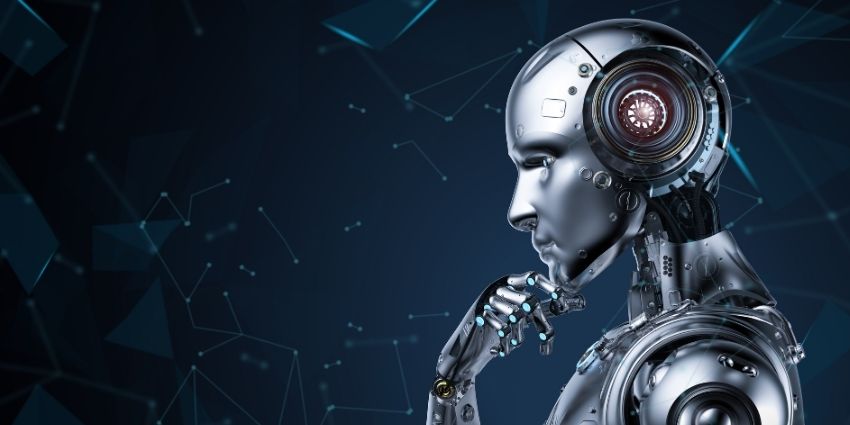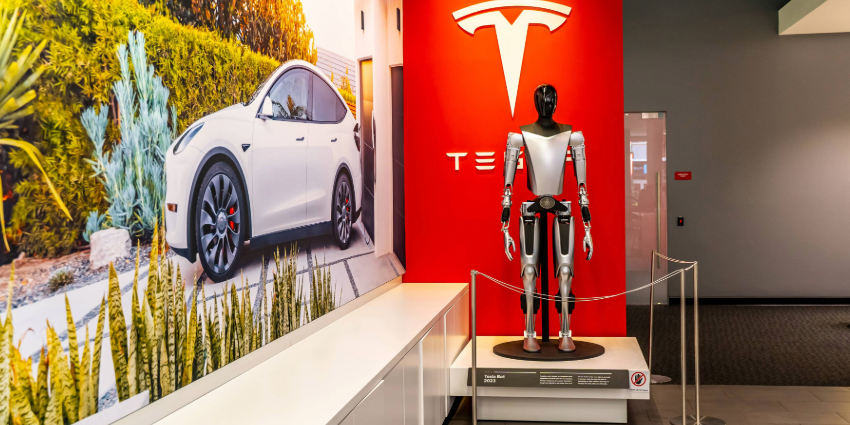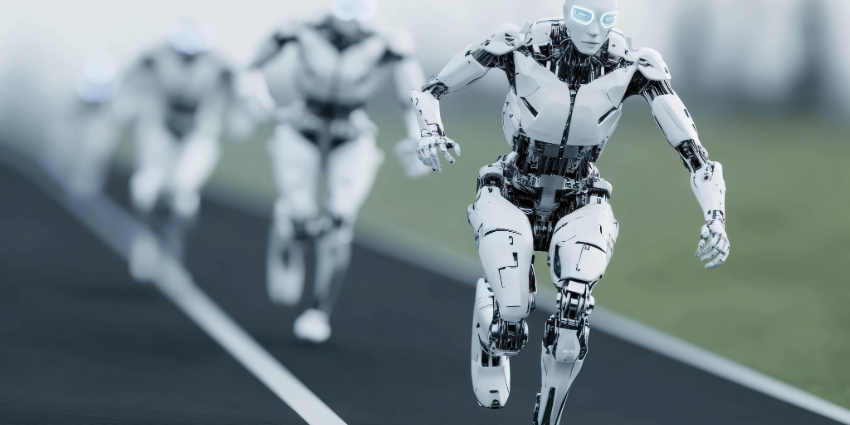What are humanoid robots, and what do they mean for the future of business automation?
If you think that news reports from the AI industry are starting to sound more and more like sections from a sci-fi novel, you’re not alone. Not only are we beginning to see new generations of AI software solutions capable of thinking, reasoning, and performing more human tasks, but now, humanoid robots are stepping into the workplace.
These AI-powered robots aren’t just transforming manufacturing floors, they’re acting as assistants, service providers, and productivity enhances across industries. Countless AI leaders are getting involved. Google DeepMind announced the arrival of Gemini Robotics in 2025. Meta announced a major investment in humanoid robotics at the beginning of this year. Even OpenAI is experimenting with the world of “physical AI”.
Then we have countless startups to consider too, like Figure AI, Agility Robotics, and Unitree. We might still be in the early stages of this robotics revolution – but the future is undoubtedly bright. Here’s how humanoid robots are going to transform the future of work.
What Are Humanoid Robots? The Rise of Humanoid Robotics
So, what are humanoid robots? Basically – exactly what they sound like – robots designed to resemble human beings. Check out Agility Robotics’ Digit robot, used for automating complex workflows in factories, or Boston Dynamics’ Atlas bot, and you’ll have a decent ideas of what these bots look like.
While functional, business-ready humanoid robots are still in the early stages of development, the dream of creating machines in our own image has been around for centuries. Back in 1495, Leonardo Da Vinci even sketched a design for a mechanical knight- a rudimentary vision of a humanoid robot.
By the early 20th century, the term “robot” officially entered our day-to-day lexicon, usually describing humanoid robotic limbs – like those used on factory floors. In the 2000s, Honda even created the ASIMO bot – capable of walking, running and recognizing objects.
What’s making humanoid robots so compelling today is the evolution of sophisticated artificial intelligence. AI serves as the “missing ingredient for creating a useful general-purpose robot,” enabling machines to perceive, learn, and interact in ways previously confined to human capabilities.
Increasingly, we’re entering an era where humanoid robots don’t just perform the same monotonous tasks repeatedly – they can act like true members of a team.
The Evolution of AI-Powered Humanoid Robots
You’re probably already aware of some of the most famous examples of AI-powered humanoid robots introduced over the years, like Hanson Robotics Sophia – which can mimic human facial expressions. But the rise of advanced technologies – like Nvidia’s Omniverse system (currently being used to train cutting-edge AI-powered robots), and advanced processors are spurring rapid growth.
In the last couple of years alone, we’ve seen countless major companies investing more heavily in humanoid robots. Tesla, for instance, plans on building thousands of “Optimus” humanoid robots this year, capable of doing various “useful things” in the workplace.
Figure, the Open-AI backed startup, recently unveiled Helix – a humanoid robot with 35 degrees of freedom and advanced AI capabilities – capable of performing tasks without extensive training. Companies like Meta have also said they’re planning on building humanoid robot hardware – initially focusing on tools that can complete household chores automatically.
As a result, the market is skyrocketing – with some analysts suggesting the space could be worth more than $38 billion by 2035.
What are Humanoid Robots? How do AI Robots Work?
An important thing to keep in mind when answering the question: “What are humanoid robots?” , is that not all “humanoid robots” are AI-powered, and not all AI systems are “humanoid robots”. Modern humanoid robots are distinguished not just by their “human-like” design, but their ability to think, reason, and complete tasks like human beings.
They take advantage of numerous technological advancements in areas like:
Natural Language Processing (NLP): Bridging Communication Gaps
Natural Language Processing (NLP) solutions and large language models form the heart of human-robot interactions today. This tech allows robots to understand and respond to human language. Through NLP, robots can interpret commands, engage in conversations, and even detect emotions via sentiment analysis.
For instance, advanced AI models like Google’s Gemini Robotics integrate language understanding to perform tasks based on spoken instructions, such as folding paper or organizing objects. In a business context, robots can serve as customer service representatives, handling inquiries and providing information with human-like empathy.
Computer Vision: Seeing and Interpreting the World
Computer Vision is the technology that gives humanoid robots the ability to interpret visual information from their surroundings. Using cameras and sensors, they can recognize faces, detect objects, track movements, and understand gestures.
For example, Tesla’s Optimus robot uses computer vision to navigate complex environments and perform tasks like carrying objects or assembling components. In manufacturing, these abilities allow robots to inspect products for quality control, ensuring consistency and reducing the margin of error.
Autonomous Decision-Making and Learning
Autonomous Decision-Making empowers humanoid robots to analyze data, learn from experiences, and make informed choices without human intervention. This involves advanced AI techniques like deep learning and reinforcement learning.
For instance, Agility Robotics’ humanoid robot, Digit, utilizes ADM to adapt to dynamic environments, performing tasks such as retrieving and carrying items in warehouses. In businesses, ADM enables robots to optimize operations by autonomously managing inventory, adjusting to workflow changes, and improving efficiency over time.
What are Humanoid Robots Used For? The Applications
Ask most people, “What are humanoid robots used for?” and they’re likely to suggest something to do with manufacturing. Obviously, the industrial sector was one of the earliest adopters of AI-powered humanoid robots. In fact, many of the biggest startups in this area quickly attracted the attention of automotive companies. Figure, for instance, earned early adoption of its robots from BMW.
There are definitely still big opportunities in this space, but on a broader scale, humanoid robots could potentially automate and enhance a wide range of tasks, across sectors.
Industrial Applications
In manufacturing and logistics, humanoid robots are addressing labor shortages and enhancing operational efficiency. Their human-like form means they can easily navigate environments designed for people, and AI means they can interact with machines and processes, just like human beings.
AI-powered humanoid robots are rapidly being integrated into factories, warehouses, and even logistics supply chains. For instance, Tesla’s Optimus robots are perfect for performing repetitive tasks in the industrial landscape. Standing at 5 feet 8 inches and weighing 125 pounds, Optimus has AI capabilities that enable it to manipulate objects with human-like dexterity.
Tesla envisions Optimus taking over tasks such as assembly line work, material handling, and even assisting in retail settings. As mentioned above, automotive companies like BMW are using humanoid robots to streamline manufacturing processes.
Another example is the “Digit” bot created by Agility Robotics, which can navigate obstacles, climb stairs, and carry packages weighing up to 40 pounds. In a recent deployment, Digit was utilized in a warehouse setting to retrieve and carry bins to conveyor belts, saving human beings time.
Healthcare Opportunities
The rise of AI in healthcare has been nothing short of incredible. AI tools are helping companies to improve data analysis, accelerate treatment development, and deliver more personalized patient care. AI-powered humanoid robots will introduce new opportunities in this landscape.
For instance, robotic assistants can provide both physical and emotional support to patients. They can also help with lifting and transporting people in healthcare settings. AI robots can also monitor vital signs, and conduct basic diagnostic processes.
One example is SoftBank’s Pepper robot, specially designed for emotional support tasks in medical environments and elderly care facilities. Another is the “Ameca” robot, created by Engineered Arts, which uses voice recognition and facial analysis to deliver empathetic patient support.
In the UK, Cera Care is even experimenting with a trial program deploying humanoid robots to support vulnerable and elderly people at home. These robots remind patients to take their medication, and alert professionals to potential health risks.
Customer Service Use Cases
So, what are humanoid robots doing in the customer service space? Well – just about everything. Robots can work as receptionists, sales assistants, and even waiters to help streamline customer experiences across industries.
As an example, KIME, the humanoid robotic bartender, created by Macco Robotics, serves drinks, snacks, and more to customers with incredible speed and efficiency. The robot can even use computer vision to recognize regular customers and customize their experience.
Elsewhere, Nadine – the socially intelligent humanoid robot created by Nanyang Technological University, has been deployed as a customer service agent in various settings. She can greet visitors in hospitality settings, answer inquiries and recommend products. Nadine can also recognize faces, speech, gestures, objects, and human emotions.
NAO, another popular example of a customer-service-focused robot created by Aldebaran Robotics, is being used in hotels and healthcare centers worldwide.
Education Applications
In educational settings and research facilities, humanoid robots are emerging as valuable interactive tools designed to engage and support students and guide teachers. These robots can act as teaching assistants, adapting learning strategies to the needs of different students.
For example, Pepper, from Softbank Robotics, has appeared in the education industry as a teaching assistant for Science, Technology, Engineering, Arts, and Math classes. Pepper’s ability to recognize faces, detect emotions, and adapt its behavior accordingly also makes it an effective tool for teaching social interaction skills and providing personalized learning experiences.
In the research sector, AI robots can support researchers by handling monotonous tasks and even dealing with dangerous discovery processes. OceanOne, created by the Stanford Robotics Lab, for instance, can explore shipwrecks and gather data from deep-sea explorations. It can even operate tools and other equipment, uncovering insights while improving human safety.
Space Exploration and Disaster Response
The answer to the question “What are humanoid robots doing to change the world?” extends further than you think. Increasingly, modern robots are extending their reach beyond terrestrial applications – playing crucial roles in developing our understanding of the universe.
For instance, developed by NASA and General Motors, Robonaut 2 (R2) is a humanoid robot that works alongside astronauts in space. R2’s human-like form allows it to operate tools and navigate environments designed for humans, making it an invaluable asset for tasks inside and outside the International Space Station (ISS).
By taking on routine or hazardous tasks, R2 enables astronauts to focus on more critical missions, thereby enhancing overall mission efficiency and safety. Valkyrie, on the other hand, was designed by NASA for disaster response missions.
Equipped with advanced sensors and dexterous limbs, Valkyrie is designed to navigate hazardous environments, operate tools, and perform tasks that would be dangerous for human responders.
The Benefits of Humanoid Robots
So, what are the benefits of humanoid robots in the business landscape? Ultimately, organizations, government groups, and individual users worldwide are beginning to discover countless advantages in using human-style robots powered by AI.
On a broad scale, humanoid robots:
- Enhance productivity: Humanoid robots are incredibly resilient. According to PWC, some can operate up to 20 hours a day, for 350 days per year, only occasionally requiring downtime for repairs. That means they deliver about four times the labor productivity of humans. They’re also more accurate, and less likely to be affected by human fatigue.
- Reduce costs: Humanoid robots could significantly reduce both labor and operational costs. A single bot could potentially complete the work of various machines and humans working in tandem. That could mean that companies have a new opportunity to accomplish more with less.
- Address labor shortages: In sectors facing significant labor shortages, humanoid robots are stepping in to fill the gaps. For instance, the U.S. manufacturing sector has been grappling with a shortage of skilled labor. Agility Robotics’ humanoid robot, Digit, is already employed in GXO Logistics’ Spanx factories, where it moves boxes onto conveyor belts, ensuring continuous operation with lower costs.
- Improve safety: Humanoid robots can safely tackle tasks that would otherwise be dangerous for humans, like working with hazardous chemicals in labs, or performing rescue operations. They can even improve worker safety in potentially risky environments, like plants and factories, keeping injuries to a minimum.
- Enable Flexibility and Scalability: Companies can program automated systems and robots to perform various tasks, making it easier for businesses to respond to new challenges. Flexible robots can help companies to rapidly adapt to new challenges and demands, without extensive training costs.
What are Humanoid Robots? The Challenges
Just like any AI revolution, humanoid robots come with challenges to address. Most of these hurdles are similar to the ones companies face when embracing agentic AI, or advanced intelligent software. For instance, companies investing in humanoid robots will need to overcome:
Technical Barriers
Though solutions like NVIDIA’s omniverse are making it easier to train humanoid robots, building efficient, reliable robots is still challenging. For instance, many modern robots (particularly those infused with AI) require substantial power to run. Current battery technologies often struggle to fuel these systems for long periods.
Plus, replicating human dexterity and movement in “robotic limbs” can be notoriously challenging. Despite progress, many robots still struggle with tasks requiring fine motor skills, limiting their effectiveness in dynamic, unstructured settings. Then there are the maintenance costs of deploying humanoid robots to consider too – reducing accessibility for smaller businesses.
Ethical Concerns
All kinds of cutting-edge AI solutions raise ethical concerns. You may already be wondering “What are humanoid robots going to do to the labor market?” If these tools can complete the same tasks humans in various sectors, will human staff become obsolete?</p></p>
Then, there are various ethical risks to consider that affect the software underpinning humanoid robots. Just like any AI solution, humanoid robots rely on extensive access to data, which can create data security and privacy risks. Plus, problems with their training data can lead to biased and discriminatory behaviors, affecting human well-being.
Plus, as robots become more autonomous, questions arise about their decision-making capabilities and the potential erosion of human oversight. Ensuring that robots act in alignment with human values and ethical principles is a complex challenge for companies to overcome.
What are Humanoid Robots? The Road Ahead
AI humanoid robots aren’t just a sci-fi concept anymore. They’re actively entering workplaces across sectors, becoming valuable companions, coworkers, and assistants in the modern world.
These solutions have the potential to revolutionize not just how we automate business tasks, but how we innovate, and evolve as a species in the years ahead.
Of course, there’s still plenty to be done before humanoid robots become commonplace in every office or home. But the technology is evolving at warp speed.
Now could be the perfect time for your business to explore the benefits and real-world use cases for humanoid robots.







